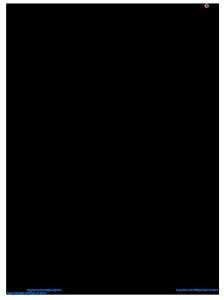Small correction required when applying the Hertzian contact model to instrumented indentation data
- PDF / 174,019 Bytes
- 7 Pages / 612 x 792 pts (letter) Page_size
- 25 Downloads / 372 Views
Instrumented indentation testing (IIT) is a relatively new form of mechanical testing which significantly expands on the capabilities of traditional hardness testing. In an IIT experiment, an indenter of known mechanical properties is pressed into contact and then withdrawn from a test material. The fundamental measurements during an IIT experiment are the applied load and the resulting penetration of the indenter into the test surface. The Hertzian contact model, or a derivative thereof, is often employed to relate these measurements to interesting mechanical properties of the test material. This article argues for a small correction to the Hertzian contact model when applied to instrumented indentation data. The magnitude of the correction primarily depends on Poisson’s ratio of the test material and the contact radius normalized by the radius of the indenter tip. Neglecting this correction can cause significant errors in the calculation of elastic modulus and hardness from instrumented indentation data.
I. INTRODUCTION
Instrumented indentation testing (IIT) is a relatively new form of mechanical testing which significantly expands on the capabilities of traditional hardness testing.1,2 In an IIT experiment, an indenter of known mechanical properties is pressed into contact and then withdrawn from a test material. The fundamental measurements in such an experiment are the load causing the two bodies to move together, P, and the resulting mutual approach of the two bodies or the displacement, h. Both P and h are measured continuously while the indenter is in contact with the test sample. Contact models are required in order to relate P and h to interesting mechanical properties of the test material. In 1882, Hertz3 provided one such model that is still commonly employed today. Assuming a rigid indenter, the Hertzian relation between load, P, and displacement, h is given by P=
4 E R1 Ⲑ 2h3 Ⲑ 2 , 3 1 − 2
(1)
where E and are Young’s modulus and Poisson’s ratio of the test material, respectively, and R is a constant describing the geometry of contact. The relation between displacement and contact radius, a, is given by h = a2 Ⲑ R
a)
.
(2)
http://journals.cambridge.org
S=
E 2Ea dP =2 R1 Ⲑ 2h1 Ⲑ 2 = 2 dh 1− 1 − 2
.
(3)
Experimentally, using paraboloid or spherical indenters is attractive because, in principle, one can determine the elastic modulus, yield stress, and strain-hardening behavior of a material all in one test.4– 6 This article argues for a small correction to the Hertzian contact model when applied to instrumented indentation data.
II. BACKGROUND
Hertzian contact analysis3 begins with the axisymmetric geometry illustrated in Fig. 1. The origin of the axisymmetric coordinate system (r, z) is the point of first
Address all correspondence to this author.
1280
Strictly speaking, the Hertzian contact model applies to paraboloids of revolution in elastic contact (a flat test surface is a special-case paraboloid). Practically, however, the use of the Hertzian model in instrumented indentatio
Data Loading...











